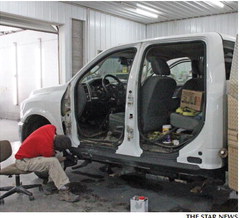Protect your vehicle from snow, ice and damage from the cold


Winter can be an unforgiving season. Freezing temperatures coupled with snow and ice can take its toll on people who live in climates where cold weather is a fact of winter life.
While winter can test people’s patience, it also can be harsh on cars and trucks. Understanding what components of a vehicle can be compromised by dropping temperatures and snowy roads can help drivers take action to safeguard their automotive investments.
While the Canadian Automobile Association notes that winter can wreak havoc on just about every part of a vehicle, there are some parts that seem to bear the brunt of Old Man Winter’s abuse. Properly servicing and caring for a car or truck can help.
Drivers should take their vehicles for a tuneup and inspection before wintry weather arrives. A mechanic will examine the car battery and check antifreeze levels and make sure that the thermostat, defroster, brakes, and even wiper blades are working effectively. Have the tires inspected for adequate tread, which can make navigating roads safer. If the treads are worn, replace the tires.
In addition to visiting their mechanics, drivers can perform some inspections and fixes themselves.
Check that all of the vehicle’s lights are operational so your car can be easily seen during inclement weather. Exchange your existing windshield washer fluid with one that will not freeze in cold conditions. Check the nozzles on the windshield-washer system routinely and clear out any blockages of ice or debris. While addressing windshield washer fluid, also replace worn out windshield wiper blades with ones that can withstand snow and icy weather.
A new coating of wax can serve as a shield against road salt, snow, sleet and rain. Try a polymer wax to protect the paint. Whenever possible, rinse off salt and grime so it does not dry on the car and gradually wear away at the paint. Some drivers mistakenly believe that salt stops being a problem once it dries simply because moisture is the active ingredient for a corrosive reaction. But humidity in the air is enough to keep the salt eating away at the car’s paint, and that can contribute to rust. Be sure to rinse off the undercarriage of the vehicle as well.
Have your tires’ alignment checked toward the end of winter or early spring. A season of traveling over pothole- ridden roads or hitting curbs buried under snow drifts can affect the alignment. Get everything back on track. Similarly, inspect tires routinely, as weather changes can affect tire pressure and strength.
Use a soft snow brush or a foam brush to clear snow off of the car. Avoid hard plastic scrapers you might use on your windshield, as they can scratch painted surfaces.
Try to park the vehicle in a garage or under a car port, each of which can protect cars and trucks from the often harsh elements of winter.
Vehicles can be affected by the cold weather. Keep them running efficiently to prevent damage this winter.





